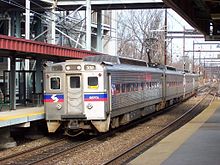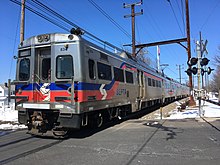Silverliner
This article needs additional citations for verification. (May 2013) |
This article cites its sources but its page references ranges are too broad or incorrect. (May 2013) |
| Silverliner | |
|---|---|
WABCO Model N-2 |
Silverliner is the name given to a series of
Silverliner I
What came to be known as the Silverliner Is were a set of 6 pilot EMUs making use of Budd's prototype Pioneer III railcar design. The 6 Pioneer III cars were purchased in response to the increasing age of the PRR's
The Pioneer III cars suffered from a low capacity main transformer as well as gearbox issues and a complex propulsion system that coupled highly sensitive mercury arc
Silverliner II
In 1963 the financial condition of the
Differences from the earlier Pioneer IIIs included a single arm

With the delivery of the second set of "Silverliners" in 1967, the original Budd Silverliners were renamed "Silverliner II" with the Pioneer III cars becoming Silverliner I.
In 1989 the entire fleet was sent to the
Experimental Silverliners
As part of the
T-1 was purchased by a private buyer in 2015 and moved to the South Carolina Railway Museum, to be converted into a lounge car. T-2 exists as an office for the AAFES warehouse in Lee Hall, VA. T-3 and T-4 are presumed scrapped, but T-4 is unaccounted for. Its whereabouts are unknown.
Silverliner III
In late 1967

Numbered 220 through 239, for their first eight years the Silverliner IIIs worked trains running into
While able to run in multiple with the later IVs, SEPTA preferred to run the IIIs either as solid sets or in conjunction with the IIs, the latter being more common due to that classes' larger size. By the late 2000s the Silverliner IIIs began to find themselves in the same position as the Silverliner IIs with increasingly unreliable components and leaking roofs. Starting in 2011 with the first deliveries of the new Silverliner Vs, those IIIs not already sidelined by mechanical issues began to be retired, a process completed by June 2012. The final run of a Silverliner III took place on June 29, 2012 with former Airport car #235 running with Silverliner II #9010 on the Cynwyd Line.
Silverliner IV
The 232-car Silverliner IV order was the largest order in the Silverliner series to date. Delivered between 1973 and 1976, the Silverliner IV cars allowed for the retirement of most of the Reading electric multiple units and PRR MP54 cars, which dated from at least the 1930s. Three times as numerous as the previous Silverliner trains put together, the Silverliner IV has been SEPTA's most common passenger railcar since 1976. Like the Silverliner II and III cars, the IV cars were owned by SEPTA and provided to the private railroads for use in their state-supported commuter rail operations until SEPTA assumed direct operation in 1983.[5][failed verification]
Features
The cars were ordered from
A readily apparent external feature of the Silverliner IV is a windowed body panel plug in the middle of the cars on each side, a provision for high-platform-only center doors which have never been installed, in contrast with
Delivery

The Reading got the first batch of Silverliner IVs in the form of 14 single unit cars produced during 1973. The first two (#9018 and #9019) were unveiled to the press on Thursday, February 21, 1974.[6] These were numbered in series with their existing Silverliner IIs, 9018 through 9031. In 1974-75 the Penn Central took delivery of 34 single units numbered 270 through 303. Delivery of the Silverliner IVs was briefly interrupted by the production of 70 Arrow II cars for the New Jersey Department of Transportation before the Penn Central received 96 pairs numbered 304 through 399.[6] Finally in 1976 the Reading took delivery of a final batch of 88 pairs numbered 101 through 188.[5][failed verification] All the IVs were delivered with the circular SEPTA logo on the left, and the Penn Central or Reading logo on the right, of all car sides and ends, although the Reading black diamond logo was omitted (and the space left blank) on cars 129-188 which were delivered after the Reading Company was absorbed into Conrail on April 1, 1976. These logos remained mostly intact until 1983, when SEPTA took over commuter rail operations from Conrail and quickly began applying its current rectangular logo over all the others.
Modifications
The Silverliner IVs have never been officially rebuilt, but there have been a number of modifications to the class. The propulsion system was initially upgraded from the original mercury arc–based Ignitron rectifiers to more reliable solid state
Service history
The Silverliner IV fleet has provided service on all of SEPTA's Regional Rail routes, providing the backbone of SEPTA's service plan with older equipment tending to be used on peak services only. Most SEPTA trains consist of a single pair of Silverliner IVs, with longer trains made up as needed. The single units are most frequently coupled to pairs to make 5 or 3 car trainsets, although single units are run alone on
Silverliner V

A total of 120 new Silverliner V cars were built by Hyundai Rotem of South Korea, with the first three entering service on October 29, 2010.[10] The cost for all 120 cars was $274 million, and they were constructed in Hyundai Rotem facilities located in South Philadelphia and South Korea.[10][11] The last of these cars was received by SEPTA in March 2013, three years behind schedule due to a variety of production problems, resulting in contractually specified delay penalties against the manufacturer totaling over $20 million.[12]
Resembling a "stretched"
All of SEPTA's Silverliner V cars were taken out of service due to fatigue cracks in the trucks on July 1–2, 2016. This caused widespread disruption of SEPTA's Regional Rail Lines.[13] As of October 5, 2016, the Silverliner V's have returned to normal service and SEPTA continued to reinstate every Silverline V car by November.
Silverliner VI
In 2017, SEPTA announced that, along with procurement of the new
Summary
| Built | Manufacturer | Model | Numbers[5][failed verification] | Total Built | Rebuilt | Weight (Ton/t)[2] |
Seats[2] | Remarks |
|---|---|---|---|---|---|---|---|---|
| 1958 | Budd | Pioneer III / Silverliner I | PRR: 150-155 PC 294-298 PC/SEPTA: 244-248 from 1974 |
6 | N/A | 85,000 lbs | 127 | #155 destroyed in accident prior to 1973. Lightest railroad MUs built in North America. |
| 1963–1964 | Silverliner II | PRR: 201–219, 251-269 Reading: 9001-9017 USDoT: T1-T4 |
59 | 1989 | 101,400 lbs | 124–127 | #210 destroyed in fire in the 1970s, #257 destroyed in fire on November 4, 2009,[17] #265 retired after rear-end collision Angora PA October 16, 1979. 269 carried PENNSYLVANIA name on letter boards until retirement. | |
| 1967–1968 | St. Louis Car | Silverliner III | 220-239 | 20 | Early 1990s | 105,504 lbs[18] | 122 (Airport cars: 90) | Originally used on what is now the Keystone Service with left-side cabs; 232–239 formerly dedicated cars for the R1 Airport Line. |
| 1973–76 | GE/Avco[1] | Silverliner IV | Original: 101–188 (Reading Pairs), 274-303 (PC singles), 304-399 (PC pairs), 9018-9031 (Reading singles) Current: 101–188, 306–399, 417–460 (married pairs) 276–305, 400–416 (single cars) |
232 | Late 1990s interior refresh | 120,600 lbs[8] | 125 | 400-series units are cars renumbered from lower series or from Reading Railroad cars 9018–9031 when PCB transformers were replaced. Original PC car series #276 through #399 is no longer continuous. Car #9020 was destroyed in rear-end collision at North Wales July 17, 1980. Car #144 heavily damaged by fire at Glenside August 29, 2018. |
| 2010–13 | Rotem | Silverliner V | 701–738 (single cars) 801–882 (married pairs) |
120 | N/A | 125,000 lbs | 110 | Replacements for 68 Silverliner II/III cars with remainder to add capacity. Placed in service between fall 2010 and spring 2013. All units temporarily withdrawn due to cracks on the components in 2016. However they returned to service in November 2016. |
References
- ^ a b Carleton, Paul (1982). Under Pennsy Wires. D. Carleton Railbooks Publication. p. 246.
- ^ ISBN 0944513050.
- ^ ISBN 1878887335.
- ISBN 0962084433.
- ^ ISBN 978-0-9621541-7-1.
- ^ a b c "Silverliner IV: New Commuter Cars for Philadelphians". Headlights. 36 (4): 14–15. April 1974.
- ISBN 0-9602080-0-3.
- ^ a b "ICC North Wales Accident Report" (PDF). Archived from the original (PDF) on March 10, 2014. Retrieved March 29, 2012.
- ^ "VIDEO: SEPTA train catches fire at Glenside, Pa. station - 6abc Philadelphia".
- ^ a b "SEPTA's new railcar model makes inaugural trip". The Philadelphia Inquirer. October 30, 2010. Retrieved November 3, 2010.
- ^ "SEPTA unveils first Silverliner V train". Progressive Railroading. November 3, 2010. Retrieved November 3, 2010.
- ^ Nussbaum, Paul (March 20, 2013). "SEPTA completes lineup of new Silverliner V cars". The Philadelphia Inquirer. Retrieved July 29, 2013.
- ^ Bohnel, Steve; Laughlin, Jason (July 5, 2016). "SEPTA urges rail riders to look into workweek alternatives". The Philadelphia Inquirer. Retrieved March 11, 2018.
- ^ "SEPTA Fleet Upgrades". Retrieved December 12, 2018.
- ^ Zuczek, Joyce (December 12, 2018). NJT Final Board Meeting Agenda (PDF) (Report). Retrieved December 12, 2018.
- ^ "Bid Item: Expression of Interest - SEPTA Silverliner VI Procurement | SEPTA". Southeastern Pennsylvania Transportation Authority. Retrieved November 14, 2023.
- ^ R5 train fire not sabotage
- ^ ICC 1979 West Chester Branch Accident Report
External links
- SEPTA Regional Rail Fleet Archived September 12, 2017, at the Wayback Machine
- Silverliner IV Specifications Archived October 5, 2016, at the Wayback Machine
